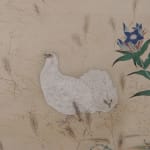



Negami Tomiji
Birds and plants, Circa 1940
Sumi ink and color on silk
52 1/4” x 16 1/2” ; scroll, 88” x 22”
$ 4,300.00
Further images
The work depicts Japanese quail (Coturnix japonica), Japanese pampas grass (Miscanthus sinensis) , and nandina. Quails, pampas grass, and nandina are all common birds and plants growing in many places,...
The work depicts Japanese quail (Coturnix japonica), Japanese pampas grass (Miscanthus sinensis) , and nandina. Quails, pampas grass, and nandina are all common birds and plants growing in many places, but the species in different part of the world not only have different appearances but are also perceived differently by humans. In Japan, artists have painted all three quite often and competed for originality in expressing their season: autumn. Negami's work is an outstanding example. His mastery of both Japanese and Western art is subtly discernible here. At the first look, he uses the then-new perspective awkwardly. It appears that each group, the group of quails, pampas grass, and nandina is on the different perspective space, and this makes them float somewhat uncertainly. However, further looking at the painting reveals that this uncertainty brings about the feeling of Japanese autumn that is transition, change, coolness, and forlornness. The artist eloquently brought the soul as well as the air, light, and smell of autumn to the work.
About the Artist
Negami was born in Yamagata prefecture in 1895. He came to Tokyo to study painting under Soho Yuuki, and Saburonosuke Okada at Tokyo Bijutsu Gakko. The former is an artist in traditional Japanese style painting and the latter in Western-style painting. After graduating from the school, he became active and thrived in the art world winning numerous prizes at salons. He died in 1981.
About the Artist
Negami was born in Yamagata prefecture in 1895. He came to Tokyo to study painting under Soho Yuuki, and Saburonosuke Okada at Tokyo Bijutsu Gakko. The former is an artist in traditional Japanese style painting and the latter in Western-style painting. After graduating from the school, he became active and thrived in the art world winning numerous prizes at salons. He died in 1981.
Signup for our Newsletter
You will receive two emails a month from us. One introduces artworks and design works from Kyoto's hidden sources and the other is stories from Misako, sharing insights into Japanese culture.
* denotes required fields
为了回应您的查询,我们将根据我们的隐私政策处理您提供的个人数据。



